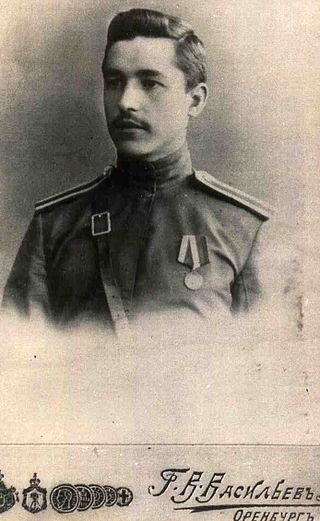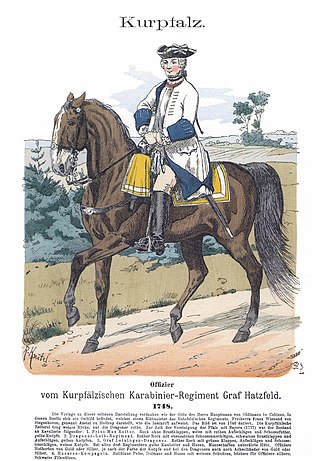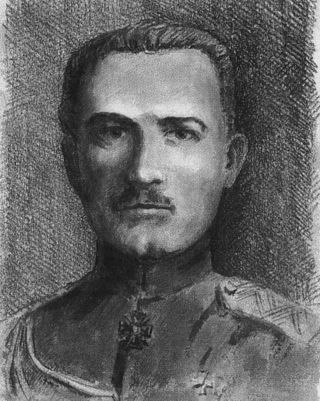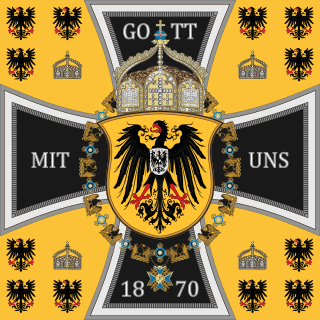See also
- General of the Cavalry
- General of the Artillery (disambiguation)
- G.I. (military), a U.S. rank thought to mean "general infantry" but comes from "galvanized iron"[ according to whom? ][ verification needed ]
General of the infantry is a military rank of a General officer in the infantry and refers to:
A general officer is an officer of high rank in the armies, and in some nations' air forces, space forces, and marines or naval infantry.

Jäger is a German military term referring to specific light infantry units.

Epaulette is a type of ornamental shoulder piece or decoration used as insignia of rank by armed forces and other organizations. Flexible metal epaulettes are referred to as shoulder scales.

The German Army is the land component of the armed forces of Germany. The present-day German Army was founded in 1955 as part of the newly formed West German Bundeswehr together with the Marine and the Luftwaffe. As of January 2022, the German Army had a strength of 62,766 soldiers.

Modern Russian military ranks trace their roots to the Table of Ranks established by Peter the Great. Most of the rank names were borrowed from existing German/Prussian, French, English, Dutch, and Polish ranks upon the formation of the Russian regular army in the late 17th century.

The term Junker (Russian: юнкер had several meanings in Imperial Russia. The Russian substantive Yunker is derived from the German noun Junker, where it means "young lord".
Gefreiter is a German, Swiss and Austrian military rank that has existed since the 16th century. It is usually the second rank or grade to which an enlisted soldier, airman or sailor could be promoted.

The Austro-Hungarian Army or Imperial and Royal Army was the land force of the Austro-Hungarian Dual Monarchy from 1867 to 1918. It was composed of three parts: the joint army, the Imperial Austrian Landwehr, and the Royal Hungarian Honvéd.

Rittmaster is or was a military rank of a commissioned cavalry officer in the armies of Germany, Austria-Hungary, Norway, Sweden, Denmark, and some other countries. A Rittmeister is typically in charge of a squadron, and is the equivalent of a Hauptmann rank.

The military ranks of the Soviet Union were those introduced after the October Revolution of 1917. At that time the Imperial Russian Table of Ranks was abolished, as were the privileges of the pre-Soviet Russian nobility.

Boris Aleksandrovich Shteifon was a Russian lieutenant general in the Imperial Russian Army, who subsequently served as a general in the anti-communist White Army, and as the leader of the Nazi-allied Russian Corps in the German occupied territory of Serbia during World War II in Yugoslavia.

The Imperial German Army (1871–1919), officially referred to as the German Army, was the unified ground and air force of the German Empire. It was established in 1871 with the political unification of Germany under the leadership of Prussia, and was dissolved in 1919, after the defeat of the German Empire in World War I (1914–1918). In the Federal Republic of Germany, the term Deutsches Heer refers to the German Army, the land component of the Bundeswehr.

The Ukrainian People's Army, also known as the Ukrainian National Army (UNA) or by the derogatory term Petliurivtsi, was the army of the Ukrainian People's Republic (1917–1921). They were often quickly reorganized units of the former Imperial Russian Army or newly formed volunteer detachments that later joined the national armed forces. The army lacked a certain degree of uniformity, adequate leadership to keep discipline and morale. Unlike the Ukrainian Galician Army, the Ukrainian People's Army did not manage to evolve a solid organizational structure, and consisted mostly of volunteer units, not regulars.

Rudolf Stöger-Steiner Freiherr von Steinstätten was a colonel general in the Austro-Hungarian army and served as the last Imperial Minister for War not only to the Austro-Hungarian Empire but also to the ancient Habsburg monarchy which sat at its head.

The Imperial Russian Army was the armed land force of the Russian Empire, active from around 1721 to the Russian Revolution of 1917. In the early 1850s, the Russian Army consisted of more than 900,000 regular soldiers and nearly 250,000 irregulars.
Colonel general is a military rank used in some armies. It is particularly associated with Germany, where historically general officer ranks were one grade lower than in the Commonwealth and the United States, and Generaloberst was a rank above full General, but below Generalfeldmarschall. The rank of colonel general also exists in the armed forces organized along the lines of the Soviet model, where it is comparable to that of a lieutenant general.
General of the Cavalry was a General officer rank in the cavalry in various states of which the modern states of German and Austria are successors or in other armies which used the German model. Artillery officers of equivalent rank were called "General of the Artillery", and infantry officers of equivalent rank "General of the Infantry".
A general of the branch, general of the branch of service or general of the ... is a three or four-star general officer rank in some armies. Several nations divide — or used to divide — their senior general officer ranks by the branch of troops they are qualified to command, or simply as an honorific title.

The Ottoman Army was the army of the Ottoman Empire after the country was reorganized along modern western European lines during the Tanzimat modernization period. It operated during the decline and dissolution of the empire, which roughly occurred between 1861 and 1918, the end of World War I for the Ottomans. The Crimean War was the first war effort in which the modern army took part in, proving itself as a decent force. The last reorganization occurred during the Second Constitutional Era.
Simeon Piščević was a Serbian memoirist and imperial Russian general.